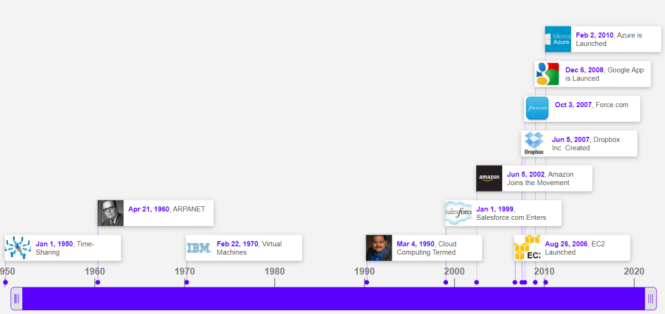

Cloud computing, the ubiquitous technology that underpins much of our modern digital world, didn’t spring into existence overnight. Its origins lie in a gradual evolution of computing paradigms, driven by a desire for scalable, accessible, and cost-effective computing resources. This article delves into the fascinating history of cloud computing, exploring its key milestones, challenges faced, and the pioneers who shaped its development. We’ll uncover the pivotal moments that led to the cloud computing revolution and examine its lasting impact on businesses and individuals alike. This article will present a structured approach, covering the early concepts, the pivotal moments, and the crucial players in the evolution of cloud computing. This structure aims to make the history easily understandable and accessible to our readers.
Early Concepts and the Seeds of Cloud Computing
The roots of cloud computing can be traced back to the early days of time-sharing systems. These early systems allowed multiple users to access a single computer simultaneously, marking a departure from the personal computer model. A significant shift occurred with the emergence of client-server architectures. This model introduced the concept of centralized resources, laying the groundwork for the distributed computing paradigm that later shaped cloud computing. The desire to share computing power and resources efficiently and affordably became a key factor in this transition. Early pioneers in the field of distributed computing and network computing laid the foundation for today’s cloud services. A crucial step in this evolution was the development of virtualization technologies. This innovation allowed multiple operating systems and applications to run on a single physical machine, significantly improving resource utilization and paving the way for future cloud solutions.
The Dawn of Virtualization and Early Cloud Platforms
Virtualization Technologies: A Cornerstone of Cloud Computing
Virtualization technologies played a crucial role in making cloud computing a reality. By allowing multiple virtual machines to run on a single physical machine, virtualization significantly increased resource utilization and reduced costs. Companies were able to scale their resources up or down easily, based on their needs, greatly improving their responsiveness to market demands. This ability to dynamically adjust resource allocation was a key driver behind the adoption of cloud computing. By simplifying resource management and streamlining infrastructure, virtualization paved the way for the next phase in cloud computing’s development. Virtualization also played a crucial role in early cloud platforms, enabling the creation of shared resources and scalable environments, an important first step towards a completely distributed computing environment. Early adopters in the tech industry were among the first to take advantage of virtualization, streamlining their IT operations and dramatically improving agility in business solutions. Companies like VMware and Microsoft became key players in the evolution of virtualization, laying the foundation for cloud computing technologies.
Pivotal Moments and Key Players in the Cloud Revolution
The Rise of Cloud Computing Providers
In the early 2000s, the stage was set for a surge in cloud computing providers. Companies recognized the immense potential of offering computing resources as a service, leading to the emergence of giants such as Amazon Web Services (AWS), Microsoft Azure, and Google Cloud Platform. These companies revolutionized the approach to hosting and managing data and applications, creating scalable, accessible, and cost-effective solutions for businesses of all sizes. Each company developed unique features, improving the overall efficiency and reducing the burden of managing infrastructure and resources. The competitive landscape incentivized continued innovation in cloud technologies, leading to features that continue to impact industries today. This period witnessed a significant shift in how businesses approached IT infrastructure and resource management.
The Impact of Cloud Computing on Business and Society
Transforming Industries and Business Models
Cloud computing has had a profound impact on businesses and society in general. The ability to access and utilize computing resources on demand has empowered businesses of all sizes to streamline operations, reduce costs, and accelerate innovation. Cloud-based applications have become essential tools for communication, collaboration, and data analysis across various industries. The advent of cloud services has also helped to democratize access to computing power, enabling small businesses and startups to compete effectively with established enterprises. Additionally, cloud computing has profoundly impacted the development of modern applications and software products. Cloud services provide a scalable platform for software development and deployment, allowing developers to focus on innovation and functionality rather than infrastructure concerns. The impact of cloud computing extends beyond business, influencing education, healthcare, and various sectors through scalable access to computing resources.
The Future of Cloud Computing: Ongoing Evolution
Cloud Computing as a Continuous Journey
Cloud computing isn’t a static entity. It’s an ever-evolving landscape, constantly adapting to new demands and technological advancements. The incorporation of Artificial Intelligence (AI), machine learning (ML), and big data analytics into cloud platforms is transforming how businesses use and manage data. This continuous evolution suggests that cloud computing will remain a crucial technology shaping the digital landscape well into the future. The increasing reliance on cloud-based services across various sectors emphasizes the importance of reliable infrastructure and security in cloud computing environments. A key aspect of cloud computing’s future lies in addressing emerging challenges such as data security, privacy, and ethical considerations.
More Insights into Early Cloud Computing Paradigms
Early Concepts in Detail
In the early days of cloud computing, the focus was primarily on centralized computing resources and how to make these resources accessible to multiple users simultaneously. The time-sharing model was a crucial first step in this process, demonstrating how computing power could be shared amongst many people. This concept was further refined with the development of client-server architectures, which established the foundation for the distributed computing model crucial to modern cloud computing.
Additional Milestones and Developments in Cloud Computing
Understanding the Pioneers of Cloud Computing
Addressing the Challenges in Cloud Computing Adoption and Implementation
Frequently Asked Questions
What are the key milestones in the history of cloud computing?
The key milestones include the development of time-sharing systems, client-server architectures, virtualization technologies, and the emergence of major cloud providers. These stages represent significant steps towards the scalable and accessible computing resources we have today. These steps illustrate the iterative process of development and innovation involved in cloud computing.
How has cloud computing impacted business operations?
Cloud computing has empowered businesses to streamline operations, reduce costs, and accelerate innovation. Businesses can access and utilize resources on demand, fostering flexibility and scalability. This impact is particularly significant for startups and small businesses, providing access to resources that were previously only available to larger enterprises. Cloud computing has also fostered a more competitive environment by leveling the playing field. This transformation highlights the power of cloud computing in modern business environments.
In conclusion, the evolution of cloud computing, from its early conceptual stages to its present-day dominance, reveals a fascinating journey of technological advancement and business innovation. The initial hurdles of trust and adoption have been overcome, paving the way for a future where cloud-based services continue to shape our digital landscape. By understanding the origins and progression of cloud computing, businesses and individuals can better navigate the evolving technological terrain and harness the transformative potential of this powerful technology. Learn more about the cloud computing services available to you now! Explore Cloud Computing Services.